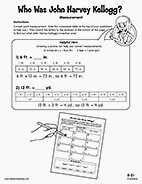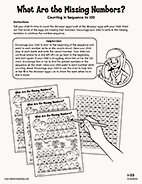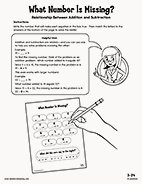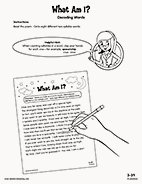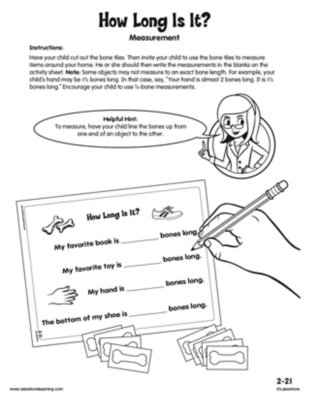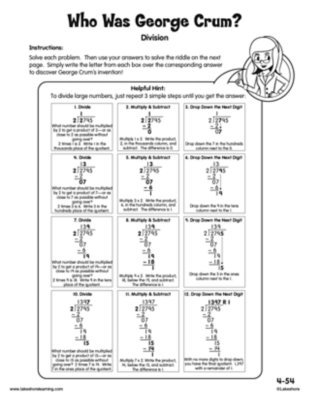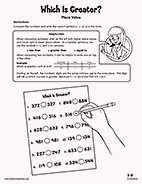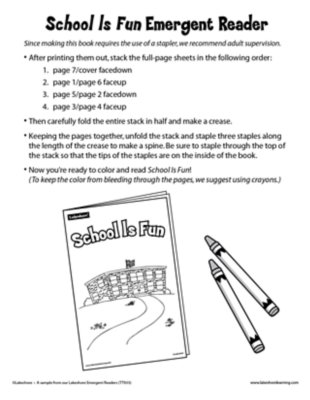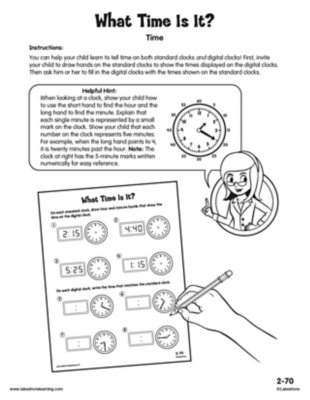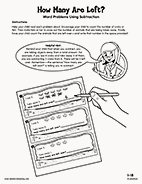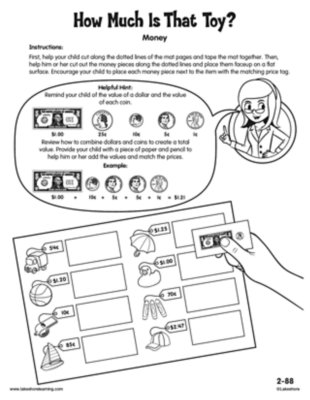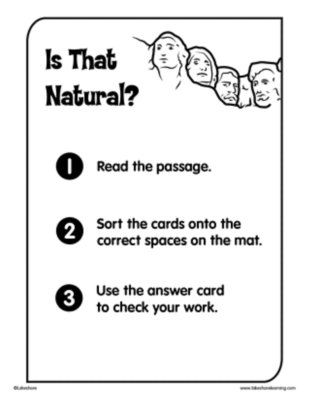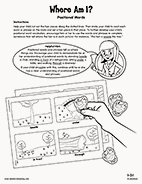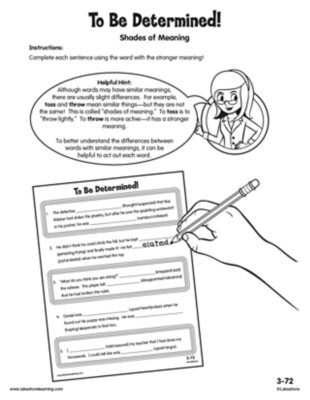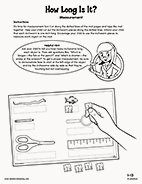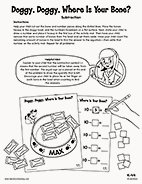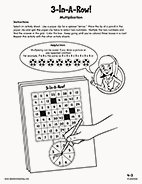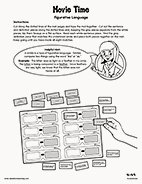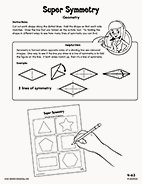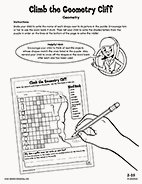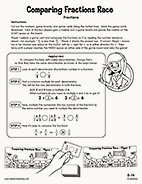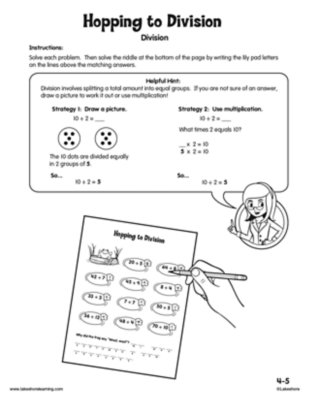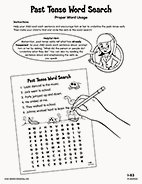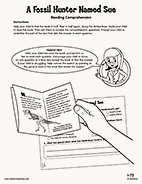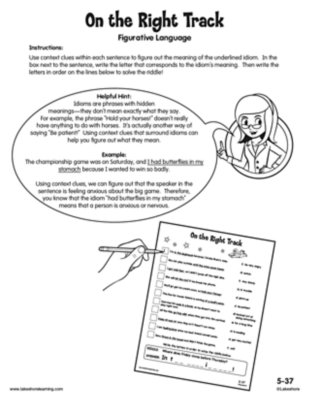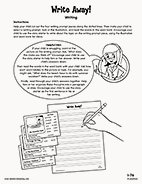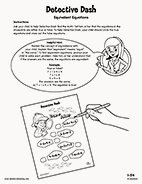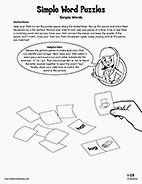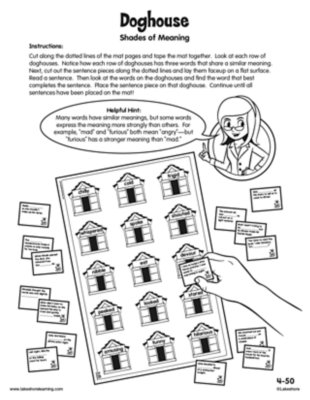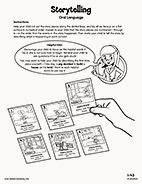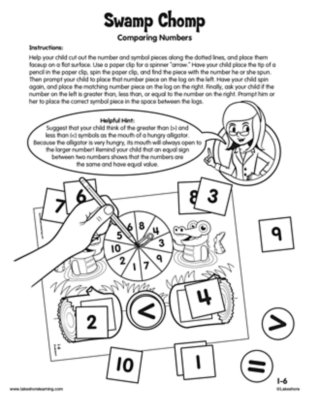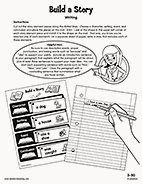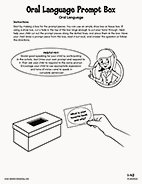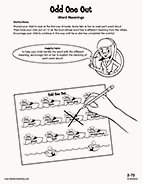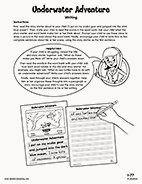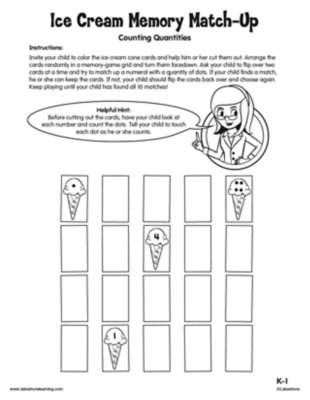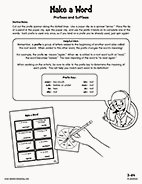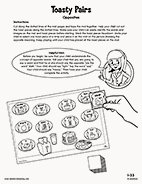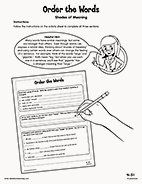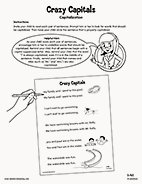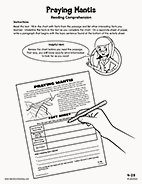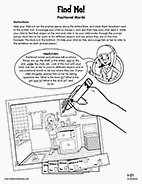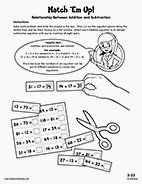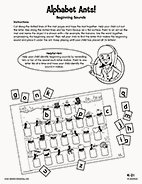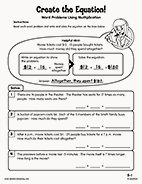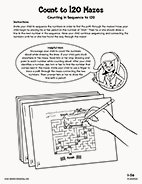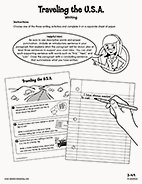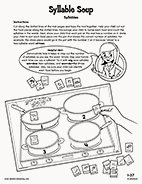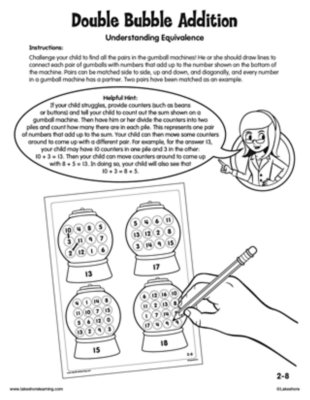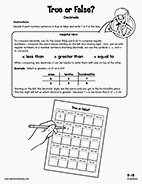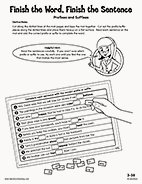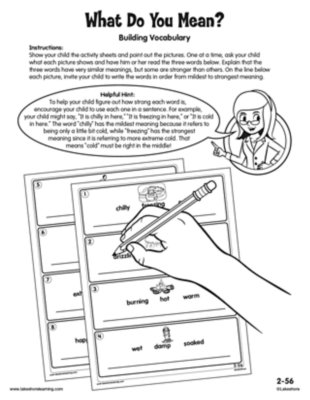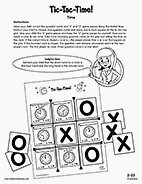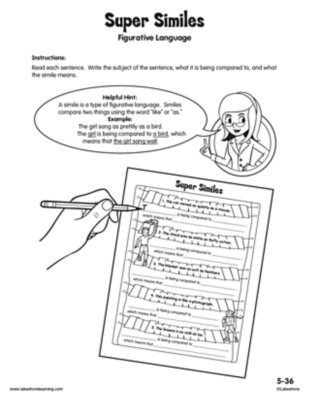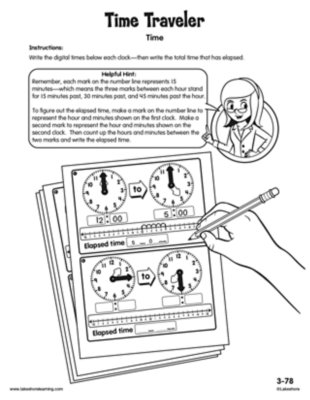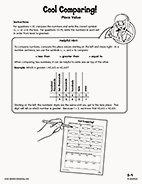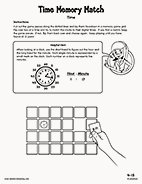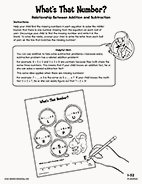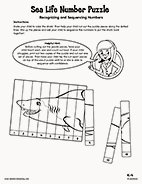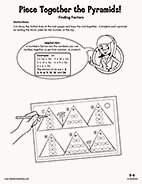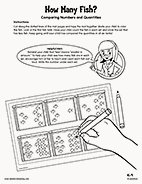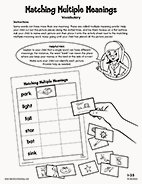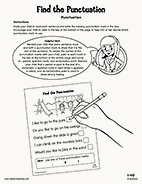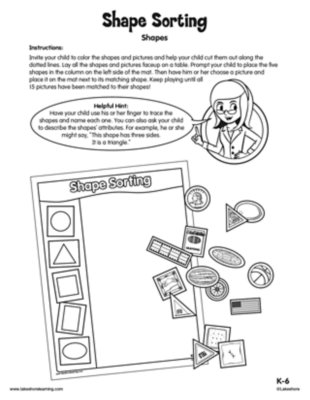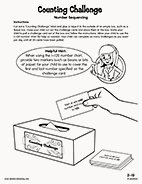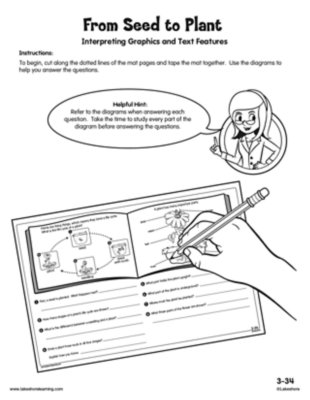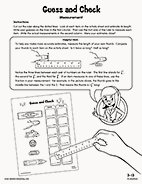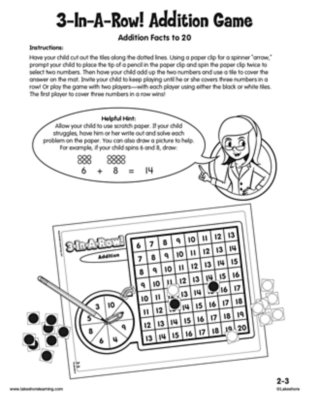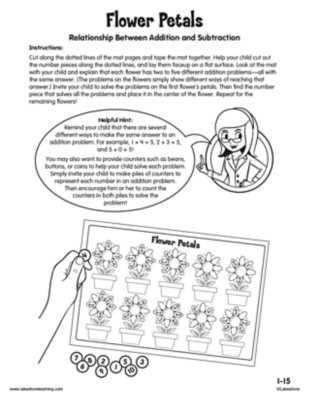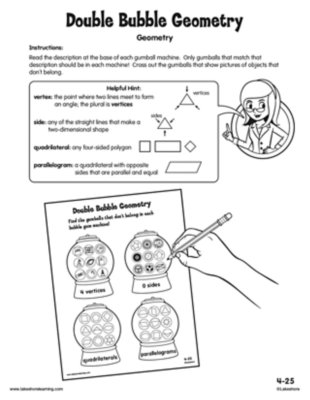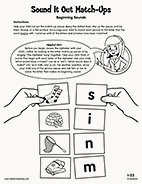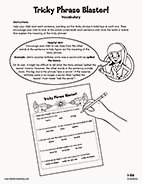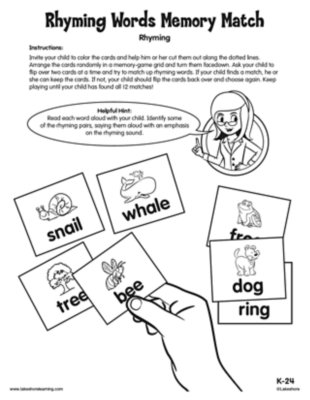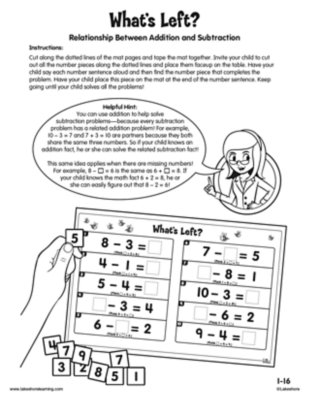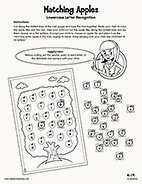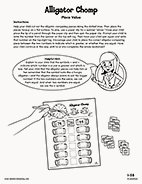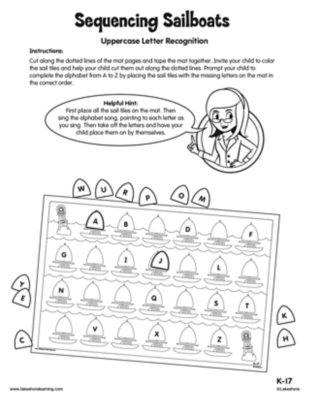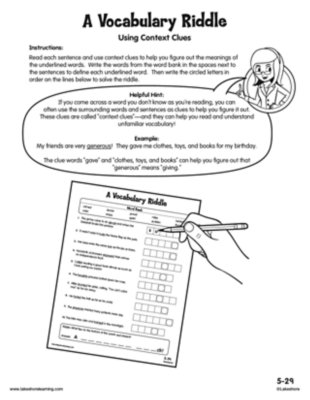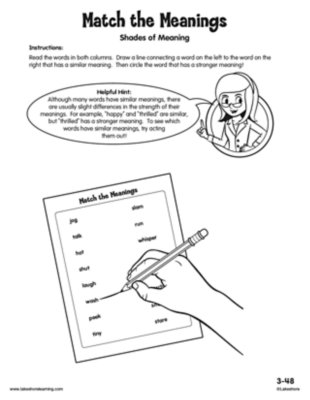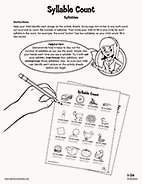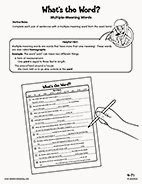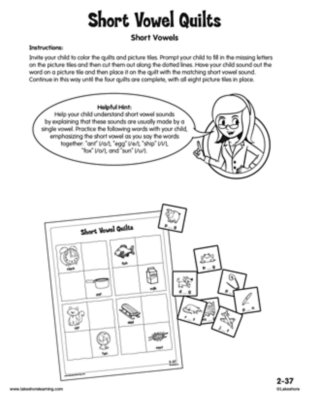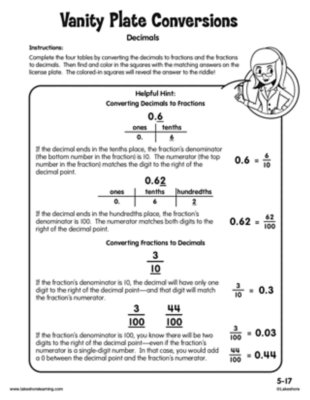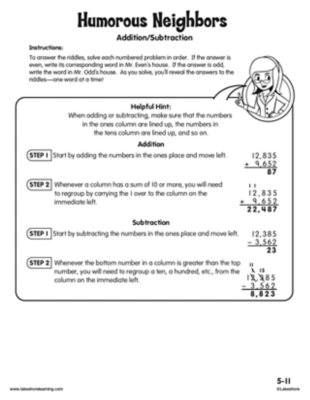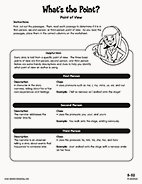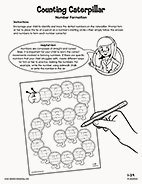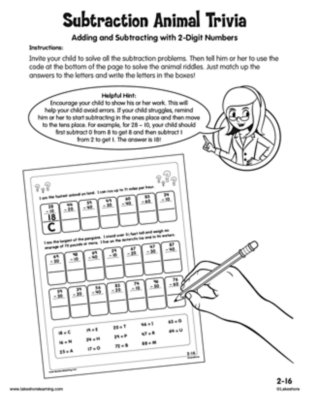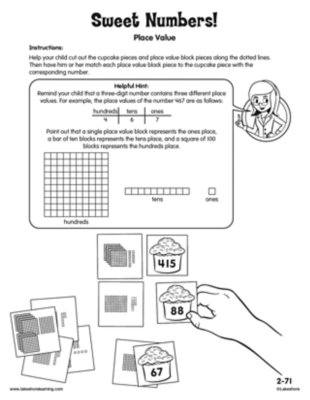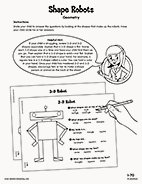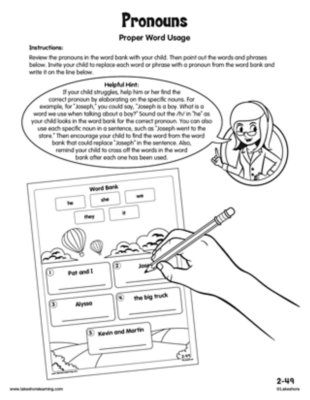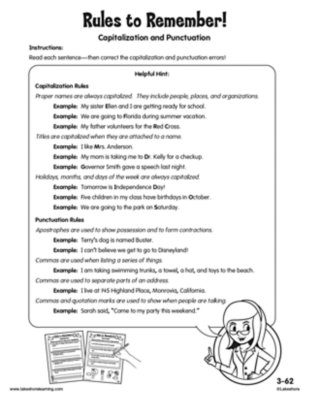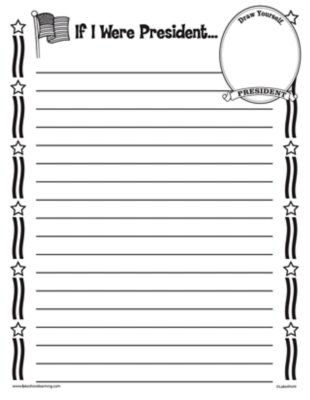
When entering fifth grade, your child should be able to solve problems involving measurement and conversion of measurement.
View worksheetDuring first grade, your child will be asked to count to 120, beginning with any number. For example, 116, 117, 118, 119, 120.
View worksheetWhen entering third grade, your child should be able to fluently add and subtract within 100 using their knowledge of the relationship between addition and subtraction. For example, your child can solve the problem 100 — 15 = 85 by understanding that 85 + 15 = 100.
View worksheetWhen entering third grade, your child should be able to decode—or read and understand—two-syllable words by applying word analysis skills and by sounding out words.
View worksheetWhen entering second grade, your child should be able to measure an object’s length by lining up multiple units of a shorter object end to end and naming how many units long the object is. For example, using paper clips to measure the length of a table.
View worksheetDuring fourth grade, your child will multiply a number with up to four digits by a one-digit number and multiply two-digit numbers by two-digit numbers. Your child will also divide numbers with up to four digits by a one-digit number, including solving problems with remainders.
View worksheetWhen entering third grade, your child should understand that the three digits in a three-digit number represent hundreds, tens and ones. Your child should also be able to write three-digit numbers in expanded form, such as writing 726 as 700 + 20 + 6. Your child should also be able to compare two 3-digit numbers using the greater than (>), less than (<) and equal to (=) symbols.
View worksheetDuring second grade, your child will learn to tell and write time from clock faces and digital clocks to the nearest five minutes. For example, 8:05 a.m. or 2:15 p.m.
View worksheetWhen entering first grade, your child should be able to solve word problems that involve adding or subtracting within 10.
View worksheetDuring second grade, your child will count dollar bill and coin combinations.
View worksheetWhen entering first grade, your child should be able to correctly use positional words, such as “above” and “between.”
View worksheetDuring third grade, your child will be expected to distinguish between shades of meaning among related words—such as “wondered,” “suspected,” “believed” and “knew”—and sort the words in order from the weakest to the strongest meaning.
View worksheetWhen entering first grade, your child should be able to describe objects by length or weight and compare objects by identifying which is longer, shorter, heavier or lighter.
View worksheetDuring kindergarten, your child will learn to add and subtract simple facts. For example, 3 + 7 = 10 and 10 — 5 = 5.
View worksheetWhen entering fourth grade, your child should understand figurative language, such as idioms, and be able to distinguish between the literal and nonliteral meanings of words. For example, “It was a piece of cake!”
View worksheetWhen entering fourth grade, your child should be able to quickly and easily solve multiplication and division facts within 100 without having to count. For example, 9 x 9 = 81 and 56 ÷ 8 = 7.
View worksheetWhen entering fourth grade, your child should understand figurative language, such as idioms, and be able to distinguish between the literal and nonliteral meanings of words. For example, “It was a piece of cake!”
View worksheetDuring fourth grade, your child will learn to identify lines and angles, understand symmetry and classify shapes based on their lines and angles. For example, your child will be able to classify right triangles by seeing that they have a 90-degree angle.
View worksheetWhen entering second grade, your child should understand the attributes of different shapes—such as a triangle’s three sides—and be able to draw a variety of 2-D shapes.
View worksheetWhen entering fifth grade, your child should be able to compare fractions, add and subtract fractions with the same denominator and multiply a fraction by a whole number.
View worksheetWhen entering fourth grade, your child should be able to quickly and easily solve multiplication and division facts within 100 without having to count. For example, 9 x 9 = 81 and 56 ÷ 8 = 7.
View worksheetDuring first grade, your child will learn subtleties in words’ meanings and make real-life connections between words and their use, such as understanding that both a bed and sofa could be called cozy.
View worksheetDuring first grade, your child will answer questions about key details in stories, such as identifying characters, settings and events, identifying who is telling the story and retelling the story in their own words. Your child will also learn to tell the difference between books that tell stories and books that provide information.
View worksheetWhen entering fifth grade, your child should be able to figure out the meaning of figurative language, including similes, metaphors and idioms.
View worksheetDuring first grade, your child will be asked to write opinion pieces, informative texts and narratives (stories).
View worksheetDuring first grade, your child will learn what the equal sign means, identify whether equations are true or false and complete equations by finding missing numbers.
View worksheetWhen entering first grade, your child should be able to spell simple words by sounding them out, such as “c-a-t” and “f-o-x.”
View worksheetWhen entering fourth grade, your child should be able to distinguish between shades of meaning among related words, such as “wondered,” “suspected,” “believed” and “knew.”
View worksheetWhen entering first grade, your child should be able to describe familiar people, places, things and events and express their thoughts, feelings and ideas clearly.
View worksheetWhen entering first grade, your child should be able to determine if a number or group of objects is greater than, less than or equal to another.
View worksheetWhen entering third grade, your child should be able to write a paragraph with an opening, three or more details and a closing.
View worksheetWhen entering first grade, your child should be able to describe familiar people, places, things and events and express their thoughts, feelings and ideas clearly.
View worksheetDuring second grade, your child will learn to determine the meanings of grade-appropriate words based on the context in which they are used.
View worksheetDuring first grade, your child will be asked to write opinion pieces, informative texts and narratives (stories).
View worksheetWhen entering kindergarten, your child should be able to count to tell the number of objects.
View worksheetWhen entering second grade, your child should be able to subtract within 20 fluently. For example, 18 — 5 = 13 and 20 — 6 = 14.
View worksheetWhen entering second grade, your child should understand that addition and subtraction are related. Your child should also be able to determine the missing number in an addition or subtraction equation. For example, 6 + __ = 8.
View worksheetDuring third grade, your child will learn to figure out the meaning of a new word when a prefix or suffix is added to a familiar word, such as figuring out the meaning of “preheat” based on the knowledge that “pre-” means “before.”
View worksheetWhen entering first grade, your child should be able to identify opposites for common adjectives and verbs, such as “happy/sad” and “stop/go.”
View worksheetWhen entering fourth grade, your child should be able to distinguish between shades of meaning among related words, such as “wondered,” “suspected,” “believed” and “knew.”
View worksheetWhen entering first grade, your child should understand that sentences begin with a capital letter and that the word “I” is also capitalized. Your child should also be able to recognize and name the punctuation marks at the end of sentences, including periods, question marks and exclamation points.
View worksheetWhen entering third grade, your child should be able to mentally add 10 or 100 to any given number from 100 to 900 without having to write down the problems and work them out. For example, 156 + 10 = 166 and 234 + 100 = 334.
View worksheetWhen entering fourth grade, your child should be able to read and analyze level-appropriate stories, dramas, poems and informational texts, identifying elements such as main ideas, key details and the author’s purpose.
View worksheetWhen entering first grade, your child should be able to correctly use positional words, such as “above” and “between.”
View worksheetWhen entering third grade, your child should be able to fluently add and subtract within 100 using their knowledge of the relationship between addition and subtraction. For example, your child can solve the problem 100 — 15 = 85 by understanding that 85 + 15 = 100.
View worksheetWhen entering kindergarten, your child should be able to identify the initial sounds in words.
View worksheetWhen entering fifth grade, your child should be able to multiply and divide to solve word problems and be able to solve multistep word problems that involve multiplication and division.
View worksheetDuring first grade, your child will be asked to count to 120, beginning with any number. For example, 116, 117, 118, 119, 120.
View worksheetWhen entering third grade, your child should be able to write a paragraph with an opening, three or more details and a closing.
View worksheetWhen entering first grade, your child should be able to count and say the syllables in spoken words. For example, your child should understand that “kitten” has two syllables: kit•ten.
View worksheetWhen entering second grade, your child should understand what the equal sign means. Your child should also be able to determine whether equations are true or false. For example, 5 + 3 = 6 + 2 is true, but 8 + 2 = 12 — 4 is false.
View worksheetWhen entering fifth grade, your child should be able to compare decimals to the hundredths place, such as 0.45 and 0.07. Your child should also be able to write fractions with denominators of 10 or 100 as decimals, such as writing 3/10 as 0.3 and writing 34/100 as 0.34.
View worksheetWhen entering third grade, your child should be able to figure out the meaning of a new word when a prefix or suffix is added to a familiar word, such as figuring out the meaning of “unhappy” based on knowledge of the word “happy.”
View worksheetWhen entering second grade, your child should be able to define words by category and key attributes. For example, “A duck is a bird that swims.”
View worksheetWhen entering second grade, your child should be able to tell and write time in hours and half-hours using clock faces and digital clocks.
View worksheetWhen entering fifth grade, your child should be able to figure out the meaning of figurative language, including similes, metaphors and idioms.
View worksheetDuring third grade, your child will learn to tell and write time to the nearest minute. Your child will also learn to solve problems in which time has elapsed. For example, “The movie started at 5:15 p.m. It was 1 hour and 20 minutes long. What time did the movie end?”
View worksheetWhen entering fifth grade, your child should be able to compare and round multidigit numbers. Your child should also be able to read and write multidigit numbers in number, word and expanded form. For example, 765; seven hundred sixty-five; 700 + 60 + 5.
View worksheetWhen entering fourth grade, your child should know how to tell and write time to the nearest minute. Your child should also be able to solve problems in which time has elapsed. For example, “The movie started at 5:15 p.m. It was 1 hour and 20 minutes long. What time did the movie end?”
View worksheetDuring first grade, your child will learn that addition and subtraction are closely related. For example, your child will solve the problem 10 — 2 = ? by understanding that 8 + 2 = 10.
View worksheetWhen entering kindergarten, your child should be able to recognize numbers 1 to 20 and count them in sequence.
View worksheetWhen entering fifth grade, your child should be able to identify whether a number is prime or composite and find all the factor pairs for a whole number between 1 and 100. Factors are the numbers that can be multiplied together to reach another number. For example, the factor pairs for 6 are 1 and 6 (because 1 x 6 = 6) and 2 and 3 (because 2 x 3 = 6).
View worksheetWhen entering kindergarten, your child should be able to count groups of up to 10 objects and determine if one group of objects is more than, less than or equal to the other.
View worksheetWhen entering first grade, your child should be able to figure out the meanings of unfamiliar words and multiple-meanings words that they encounter in kindergarten-level texts.
View worksheetWhen entering first grade, your child should understand that sentences begin with a capital letter and that the word “I” is also capitalized. Your child should also be able to recognize and name the punctuation marks at the end of sentences, including periods, question marks and exclamation points.
View worksheetWhen entering kindergarten, your child should be able to identify simple shapes—such as squares, circles, triangles and rectangles—and describe objects in the real world using shape names.
View worksheetWhen entering second grade, your child should be able to count, read and write numbers up to 120, beginning with any number. For example, 116, 117, 118, 119, 120.
View worksheetWhen entering third grade, your child should be able to use text features—including diagrams, bold print, glossaries and indexes—to locate facts in informational texts, such as newspapers, magazines or science books.
View worksheetWhen entering third grade, your child should be able to measure, estimate and compare the lengths of objects in standard units, such as inches, feet, centimeters and meters.
View worksheetWhen entering second grade, your child should be able to add to 20 fluently. For example, 5 + 9 = 14 and 13 + 7 = 20.
View worksheetWhen entering first grade, your child should be able to use objects or drawings to answer “How many more make 10?” when given a number. Your child should also be able to use objects or drawings to break apart any number up to 10 in more than one way, such as breaking up the number 7 into 5 and 2, as well as 3 and 4.
View worksheetWhen entering fourth grade, your child should understand that different types of shapes can share the same attributes. For example, rhombuses, rectangles and squares all have four sides and are part of a larger group called quadrilaterals.
View worksheetWhen entering first grade, your child should be able to identify the beginning and ending sounds in simple words, such as identifying the “b” sound in “bat” or the “n” sound in “pen.”
View worksheetDuring first grade, your child will learn to figure out the meanings of new words and multiple-meaning words based on the context in which they are used.
View worksheetWhen entering kindergarten, your child should be able to recognize and match words that rhyme.
View worksheetWhen entering first grade, your child should be able to use objects or drawings to answer “How many more make 10?” when given a number. Your child should also be able to use objects or drawings to break apart any number up to 10 in more than one way, such as breaking up the number 7 into 5 and 2, as well as 3 and 4.
View worksheetWhen entering kindergarten, your child should be able to recognize and name some lowercase letters, especially those in your child’s name.
View worksheetDuring first grade, your child will learn to compare two-digit numbers using greater than (>), less than (<) or equal to (=) symbols, such as 22 > 12. Your child will also learn that 10 can be thought of as a group of 10 ones—called a “ten.”
View worksheetWhen entering kindergarten, your child should be able to recognize and name some uppercase letters, especially those in your child’s name.
View worksheetWhen entering fifth grade, your child should be able to figure out the meaning of an unfamiliar word or phrase by using clues in the text, such as definitions or examples.
View worksheetWhen entering third grade, your child should be able to distinguish shades of meaning among closely related words—such as “toss,” “throw” and “hurl”—and identify which word has the strongest meaning.
View worksheetWhen entering first grade, your child should be able to count and say the syllables in spoken words. For example, your child should understand that “kitten” has two syllables: kit•ten.
View worksheetDuring fourth grade, your child will be asked to figure out the correct meanings of multiple-meaning words that appear in fourth-grade texts, such as knowing when the word “pitcher” refers to a container for pouring liquids or a person throwing a ball.
View worksheetWhen entering second grade, your child should be able to distinguish short vowels from long vowels in spoken one-syllable words, such as hearing the short “a” sound in “cap.”
View worksheetWhen entering fifth grade, your child should be able to compare decimals to the hundredths place, such as 0.45 and 0.07. Your child should also be able to write fractions with denominators of 10 or 100 as decimals, such as writing 3/10 as 0.3 and writing 34/100 as 0.34.
View worksheetWhen entering fifth grade, your child should be able to easily add and subtract multidigit whole numbers.
View worksheetDuring fifth grade, your child will learn to describe how a narrator’s or speaker’s point of view influences the way events are described. Your child will also learn to identify the point of view in which a text is written (first person, second person or third person).
View worksheetWhen entering first grade, your child should be able to print many uppercase and lowercase letters and write numbers 0 through 20.
View worksheetWhen entering second grade, your child should be able to add and subtract using a two-digit number and a one-digit number, as well as a two-digit number and another two-digit number. For example, 22 + 20 = 42 and 41 — 10 = 31.
View worksheetDuring second grade, your child will learn to identify groups of hundreds, tens and ones when counting. Your child will also learn that the three digits in a three-digit number represent hundreds, tens and ones. For example, there are 7 hundreds, 2 tens and 6 ones in the number 726.
View worksheetDuring first grade, your child will learn the attributes of many shapes—such as the fact that a triangle has three sides—and how to divide circles and rectangles into halves and fourths. Your child will also be asked to find shapes within shapes, such as turning a square into two triangles by drawing a line from one corner to the opposite corner.
View worksheetWhen entering second grade, your child should be able to correctly use pronouns, singular and plural words, and past-, present- and future-tense words in sentences.
View worksheetDuring third grade, your child will learn to capitalize the appropriate words in titles, such as the names of books and movies. Your child will also be expected to use commas in written addresses and with quotation marks to show when someone is speaking.
View worksheet
